Two-parts aluminum and three-parts of oxygen (Al2O3) are all that is needed to create one of the hardest minerals on earth: corundum. Diamond has a hardness of 10 on the Moh's Scale. Several other minerals rank 9.5 but are either rare in nature or do not lend themselves to be made into gemstones. As far as naturally-occurring minerals that make fine gemstones, corundum is next after diamond, at 9 on the Moh's Scale.
When aluminum and oxygen bond to form corundum in its purest form, it is colorless, a translucent stone. But, other elements are often present in trace amounts and become part of the matrix. The element chromium will make the corundum red, and it is then called a ruby. When other elements are present, causing the corundum to be any color but red, it is then called sapphire. The commonly seen blue color is caused by iron and titanium, but vanadium, magnesium, or other elements can lead to sapphires with yellow, green, orange, or purple colors.
The photo below shows a sapphire (left) and a ruby (right). The copper penny in the photo, for size comparison, is 19.05 mm (0.75 in) in diameter. [source] I bought those two pieces from a gem supplier on eBay long ago just to have a cut-and-polished specimen of both ruby and sapphire in my gem collection. I considered having one or both of them mounted in a pendant for wearing, but I have enough pendants as it is. So, they will probably remain unmounted, for now.

The sapphire and the ruby in the above photo are rather unique, as opaque stones such as these are seldom cut with facets as these are. Gem cutting (with facets) is usually reserved for translucent stones and mounted in such a way to allow light to pass through them.
Sapphire is officially my birthstone according to most jewelers, but the pretty violet-red hues of the ruby has made it my favorite of the precious gemstones. It might seem rather odd to some people, but given the choice between a ruby and a diamond, I would prefer a ruby! 😍
I have already written about rubies in my blog, in two parts. The first dealt with the appearance of the crystals, themselves, as found in nature and how they look when cut and polished. The second part features some jewelry with ruby stones. Interested parties can find those posts here:
• Ruby – Part 1: Crystals
• Ruby – Part 2: Jewelry
Since sapphires and rubies are identical from a chemical and geological perspective, much more can be learned about sapphires by reviewing the first of those two linked articles. Of particular interest might be the effects of chatoyancy that creates an asterism, or star pattern, just under the surface of the some specimens (called a "star sapphire").
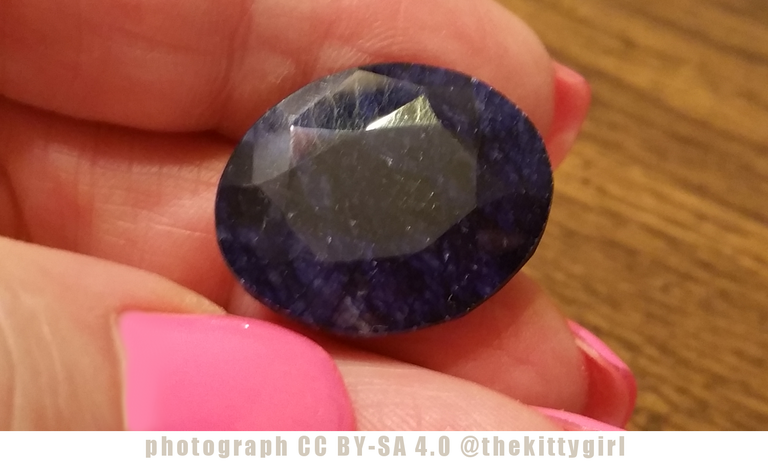
I have four pieces of sapphire jewelry, none of which was terribly expensive. The first is a ring that I've had so long that I can't remember where or when I got it. It features four small sapphires set in a thin gold band with itty-bitty diamond chips between them. It's pretty, but very small and unassuming.
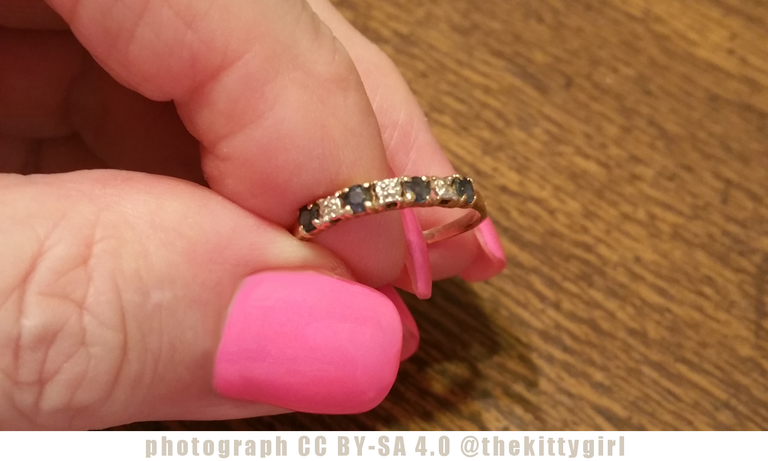
Next is a charming little 14K gold ring that I've had for maybe 35 years or so. It was purchased on a whim at a jewelry store in Boston when I was there on business, back in the 1980s. I had a little discretionary money with me and saw the little ring and loved it for its simplicity and the lovely sapphire stone that was mounted in it. I left the shop, trying to be good about not spending such a chunk of my money in one place. A day or two later, though, I decided that was what I wanted more than anything else and fortunately it had not sold. If I remember correctly, I paid about USD $70 for it. It is a sturdy little ring, and suitable for everyday wear. I wore it daily as a pinky ring for many years until I switched to mostly silver jewelry, but still wear it occasionally now.

Then there is this ring. It was purchased online from a family-owned business called Walter Bauman Jewelers to celebrate a promotion at work to a middle-management position back in the early 2000s.

The stone is a natural, oval-cut sapphire which is flanked by two small diamonds. The setting is white gold, and marks my transition from gold-toned jewelry to white-toned jewelry.
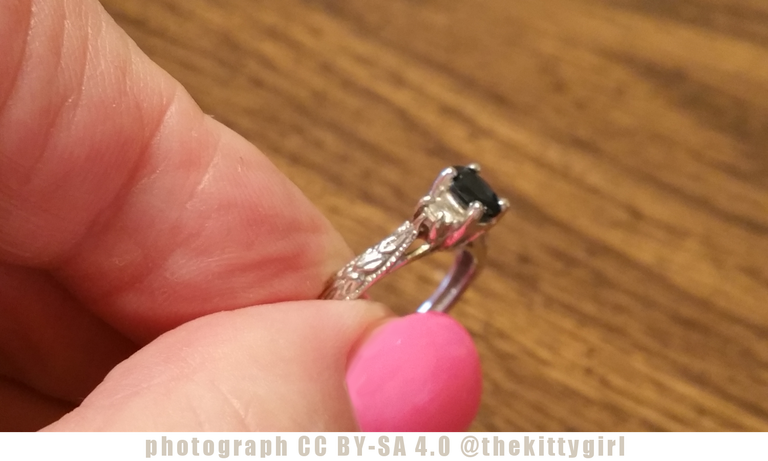
This fancy little ring is mostly worn just for special occasions, definitely not an everyday ring to wear doing housework and such! Since sapphires are such a dark stone, the setting on this ring was built-up higher than usual to allow more light to enter the stone. That is yet another reason this isn't ideal as an everyday-ring. Even with the taller setting, not much light penetrates the darkness of this sapphire. I've heard it said that the darker the sapphire, the better the quality, but I am not sure if that is true or not.
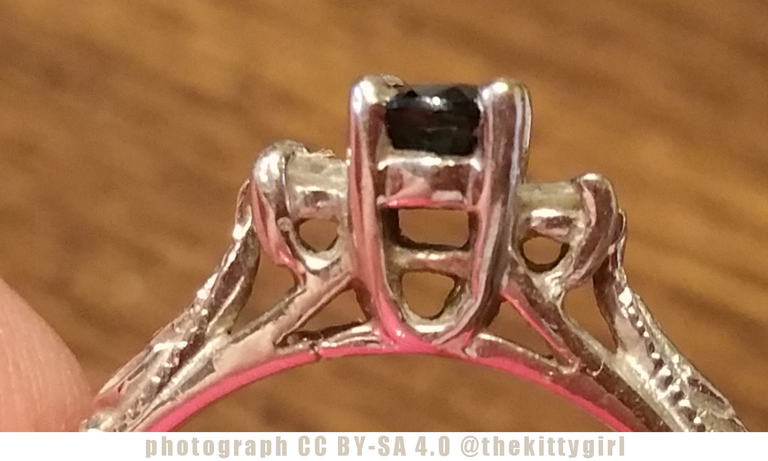
So, that is the little trio of sapphire rings in my jewelry collection, all acquired at various points during the last 40 years of my life.
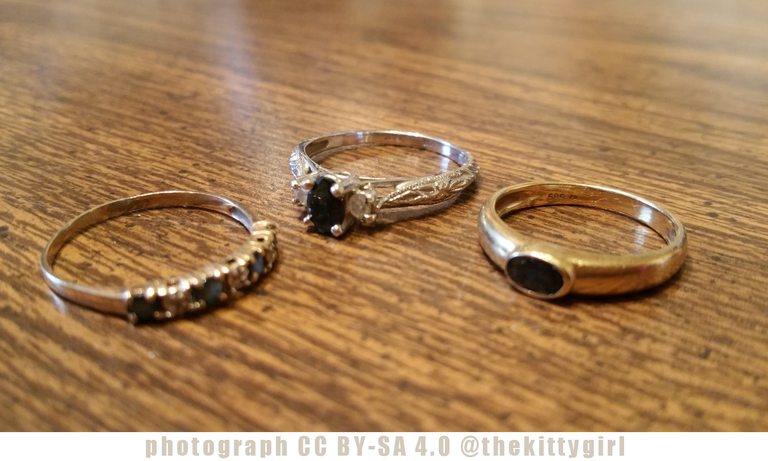
Here are the rings again with the unmounted sapphire for size comparison:

I also have a pair of earrings, but the sapphires in them were grown from a slurry of minerals in a laboratory. I hesitated at first to get lab-grown sapphires, but logic prevailed, as I know they have the same chemical structure as natural sapphires have. Growing gemstones in a lab requires providing the same raw materials and conditions (pressure, heat, etc.) that Mother Earth provides. At the time, I couldn't afford real sapphire earrings, so I settled on these and have enjoyed them for several years now whenever I wear blue outfits. I got these from Walmart about five years ago, but here is what a popular jewelry company has to say about lab-created stones:
Lab-created gemstones are real gemstones, not synthetic imitations. They have the same chemical, optical and physical characteristics as stones dug from the ground. This category of gems includes popular options such as lab-created sapphires, lab-created diamonds and even rare colors of natural gemstones. They sparkle and gleam like stones made in nature and work for many styles and settings. [source]
So here are my earrings with the lab-created sapphires set in sterling silver, with two little cubic zirconias accompanying the sapphires. They are lightweight, pretty, and fun to wear.
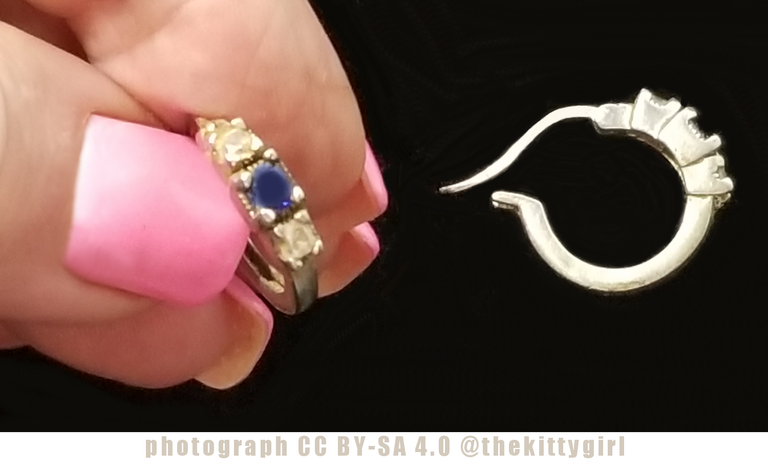
I hope everyone has enjoyed this journey through the fascinating world of gemstones and has learned something about sapphires.
 😊
😊SOURCES
1 Geology.com: Ruby and Sapphire
2 JaredJewelers: Lab Created Gemstones
3 Minerals.net: Sapphire
4 Wikipedia: Sapphire

Phogopite • Lepidolite • Muscovite • Dichroic Glass
Goldstone • Aventurine • Amber • Black Star of India
Ruby – Part 1: Crystals • Ruby – Part 2: Jewelry • Larimar
Citrine Crystal • Amethyst Crystal • Kitty Geode • Phoenix Crystal
Barbeque & Amethysts • Salt Lamps • Trilobite • Arrowhead
Garden Quartz, freeform • Granite Quarry № 2 • Apophyllite
Rocks from Space! • Quartz Rock: Raw vs Polished
Chrysocolla • Tourmaline • Bornite • Goethite
Small Quartz Crystal • Smoky Quartz • Tibetan Quartz
Amazonite Beads • Zoisite • Rutilated Quartz
Garnet • Amazonite Sphere • Lapis Lazuli Mala
Amethyst Point • How Rocks Get Their Color • Red Jasper
Ring, Ring! Amethyst Calling! • Lapis Lazuli • Turitella Agate






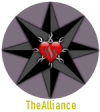




24-Nov-2020
This post has received a 100.00% upvote from @fambalam! Join thealliance community to get whitelisted for delegation to this community service.
View or trade
BEER.Hey @thekittygirl, here is a little bit of
BEERfrom @pixresteemer for you. Enjoy it!Learn how to earn FREE BEER each day by staking your
BEER.Well, I'm like you. I prefer the Ruby-but it is my birthstone. I have a few rings but the ONE is a rectangular Ruby that my grandfather wore.
I have mined just a little Saphire in Idaho maybe 40 years ago. We sold the hygraded ore to a guy (I think we got $50 per pound) and it was a great way to pay for some time in the deep wilderness. I wish I'd have kept a couple of samples...
I just recently found a piece of a little flint node out in the desert. The entire node would have been maybe 4 inches in diameter and this is a wedge out of the node. I've looked a couple of times in the area and can't find any more pieces, but I was excited anyway. It fractured in a nice sharp edge and you can easily see how it could be shaped into a tool.
Thanks for another great post. I really appreciate it.
Big fan of rubies myself and even though my birthstone is a diamond, I would rather have a sweet candle-apple ruby shining on my watch. Plus, ya know, Fleet Street. 😜
I like both ruby and sapphire, and I believe I've read your articles on ruby.
These are two of the stones (the third one would be emeralds) that interest me.
Which of the stones are your favorites?
I really like the blue one. It is beautiful and shiny. My sister loves shiny stuff. 🌟
amigo,gracias por compartir tan buen trabajo,espero este bien,vivo en venezuela ,estoy en esta plataforma buscando ayuda y nuevo ingreso para sobrevivir,cualquier cosa cuento con su ayuda,visitando mis trabajos
Thanks for continuing to make Hive awesome.